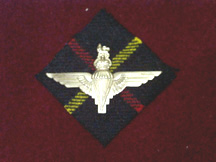

5th (Scottish) Parachute Battalion

"What manner of men are these who wear
the maroon beret?..........
They have shown themselves to be as tenacious and determined
in defence, as they are courageous in attack. They are in fact
men apart. 'Every man an Emperor' "
'Field Marshall The Viscount Montgomery of Alamein'
Chlanna nan con thigibh a so's gheib sibh feail!
Originally formed from the 7th Battalion, Queen’s Own Cameron Highlanders, in May 1942, the 7th Battalion,"The Cameron Highlanders" started the war serving in 227th Independent Infantry Brigade until 18 November 1941 when they were moved to 46th (Highland) Infantry Brigade, 15th (Scottish) Division. They were transferred out of 15th (Scottish) Division on 24 March 1942, and trained as paratroops - becoming the 5th (Scottish) Parachute Battalion, The Parachute Regiment. The 5th (Scottish) parachute Battalion was part of the 2nd Parachute Brigade, 1st Airborne Division. As was typical of young men raised during the depression era, not all of the members of the QOCH’s met the tough physical standards of the new airborne unit so other Scottish Regimental volunteers were added to the 5th to fill its ranks.
It was not unusual to see the new paratroopers of the 5th wearing a vast array of tartans and clan crests on their Tam’s. One may have seen a selection of Gordons, Seaforths and Stuart tartans among this new unit. Until the adoption, by the 5th in September 1943, of the traditional airborne maroon beret, the 5th settled for the Army Air Corps Cap Badge worn on their tam over the Stuart Hunting Tartan.
Originally commanded by Lieutenant Colonel A. Dunlop, the 5th began its training in England and was ready for action by March 1943. The 5th would see its combat debut, under the command of Lieutenant Colonel C. B. Mackenzie, on July 9, 1943 during the invasion of Italy.
Comming ashore in the van of the 2nd Brigade at the harbor town of Taranto, the 5th quickly moved out and captured their primary objective, a small town twelve miles east of Taranto. While the remainder of the battalion secured the town, its pipe band marched up and down the main street playing Johnny Cope. The 5th remained in action with the 1st Airborne Division until November when it remained with the 2nd Parachute Brigade in Italy, renamed the 2nd Independent Parachute Brigade, while the 1st Airborne Division returned to England.
The 2nd remaind in Italy as the sole representative of the Parachute Regiment in the Mediterranean theater of operations. The 2nd was under the command of Brigadier C. H. V. Pritchard. They were attached to the 2nd New Zealand Division.
The 5th was immediately involved in action at the River Sangro. Located on the left flank of the 8th Army, the battalion was involved in a long muddy action as the river was in flood stage the ‘size of the Thames at Hammersmith!’ The entire Brigade began a long period of fighting that would see many irreplaceable casualties.
During this period, the 5th was opposite the main enemy line of resistance in the Salora sector. It was while in this sector that the first decoration of note, the Military Medal, which was earned by Private Morris in actions against the enemy. The 5th was relieved later by the 4th Battalion.
The 2nd Independent Parachute was tasked with the airborne portion of Operation Anvil-Dragoon, the invasion of Southern France. On D-Day, the 5th Battalion dropped over 20 miles inland due to inacurate positioning by the USAAF C-47s. The 5th and the rest of the 2nd IPB were very successful in the quest for the objectives. While in France, the 5th worked especially well with the Maquis, the French Underground. It was during this period that the 5th aquired its largest collection of vehicles. They ranged from a steam powered 5-ton truck to a hearse. All were left behind when the battalion returned to Italy.
The 5th next served in Greece (14 October 1944 - 28 January 1945), where they were sent to assist the Democratic Greek government in suppressing the revolt of the Communist ELAS forces. On 1 February 1945 the Brigade returned to Italy where it remained until the cessation of hostilities.
Minimum Equipment Requirements:
1. WWII British battledress and Denison Smock
2. 1937 pattern web gear: waist belt, universal pouches, pair of braces, water
bottle and
carrier, bayonet frog and pair of gaiters
3. British ammunition boots
4. British Parachutist Steel helmet and maroon beret
5. No. 4 Mk 1/2 Lee Enfield .303 caliber rifle and No. 4 Bayonet and sheath.
Commander:
Lance Jones (770) 830-2347 or E-mail
Recommended Uniform vendor:
King and Country
 |
 |